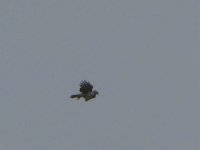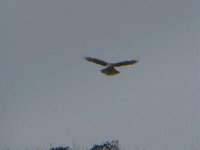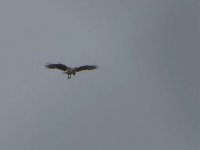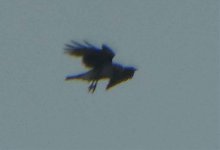-
Welcome to BirdForum, the internet's largest birding community with thousands of members from all over the world. The forums are dedicated to wild birds, birding, binoculars and equipment and all that goes with it.
Please register for an account to take part in the discussions in the forum, post your pictures in the gallery and more.
You are using an out of date browser. It may not display this or other websites correctly.
You should upgrade or use an alternative browser.
You should upgrade or use an alternative browser.
Possibly Booted Eagle? (1 Viewer)
- Thread starter Stevebirder
- Start date
More options
Who Replied?Stevebirder
Member
Many thanks
Short-toed Eagle is a vagrant to Canary Isles, so I suggest you contact Eduardo Garcia del Rey here, as I'm sure he would be interested;
https://www.facebook.com/groups/276782382519997/
Screen shot of STEagle status attached. 11 records/6 from Tenerife.
https://www.facebook.com/groups/276782382519997/
Screen shot of STEagle status attached. 11 records/6 from Tenerife.
Attachments
Can't see STE here.. Looks like a Buteo sp. so my thoughts are LLB.
Long-legged Buzzard is a vagrant to Canary Isles too. It is actually rarer than STEagle. See attached.
Attachments
Stevebirder
Member
We saw a number of CBs on the visit, and others, but somehow this struck us as a bit different; long "fingers", dangling legs, and quite active.
Then a pale Common Buzzard is more likelyLong-legged Buzzard is a vagrant to Canary Isles too. It is actually rarer than STEagle. See attached.
lou salomon
the birdonist
...It has 5 fingers, so, case is settled.

...It has 5 fingers, so, case is settled.
Lou, could well be a Buzzard, but I don’t think it is that straightforward
https://www.birdforum.net/gallery/showphoto.php?photo=588824
1. would you see the 6th finger on this bird in a low quality pic? Or do I see a hint of a 6th finger in the OP?
2. have you ever seen such a long alula in a Buzzard?
3. I have never seen a white Common Buzzard on the Canary Islands but I was never in Tenerife
Deb Burhinus
Used to be well known! 😎

Why not a Bonelli’s? Birds from the various LIFE BONELLI projects over the past few years (and ongoing) in various parts of the Med are beginning to disperse quite widely. Often showing 5 fingers in flight, plumage impression could fit, (and individuals have been tracked crossing straits of Gib). They do have feathered tarsi but not so much that could not be swept back in flight when legs ‘hang’
(Just because two birds were seen together, it doesnt mean they were a pair or even the same species)
Just a thought.
https://www.jpgbirding.com/Birds-Raptors/Bonellis-Eagle/i-BtF8kb5
https://www.petzl.com/fondation/projets/conservation-aigle-de-bonelli?language=en
(Just because two birds were seen together, it doesnt mean they were a pair or even the same species)
Just a thought.
https://www.jpgbirding.com/Birds-Raptors/Bonellis-Eagle/i-BtF8kb5
https://www.petzl.com/fondation/projets/conservation-aigle-de-bonelli?language=en
Last edited:
Simon Wates
Well-known member
FWIW I thought the head shape perfect for a Buteo and too small for Short-toed and Bonelli's, lacking the latter's large deep bill and generous strong neck. To me, the wing length is too short too.
Last edited:
Deb Burhinus
Used to be well known! 😎

another image not vastly different positioning of tail and legs to op bird
http://www.oiseaux.net/photos/marc.fasol/bonelli.s.eagle.5.html
I take on board what you said Steve but is the length of neck and depth of bill subject to impressions depending if angle of view? The bill is short and are the wings really comparatively so long?
Some very good images here
http://birdingandwildphoto.es/en/hide/bonellis-eagle-hide/
http://www.oiseaux.net/photos/marc.fasol/bonelli.s.eagle.5.html
I take on board what you said Steve but is the length of neck and depth of bill subject to impressions depending if angle of view? The bill is short and are the wings really comparatively so long?
Some very good images here
http://birdingandwildphoto.es/en/hide/bonellis-eagle-hide/
Last edited:
lou salomon
the birdonist
Such a whitish bird would be an adult or at least 4cy if Bonelli's Eagle and in that case it would show the black midwing line. Wing shape also wrong.
Deb Burhinus
Used to be well known! 😎

So buteo buteo then by majority view 
Although personally I’m not convinced by the 3rd image for buteo at all, noting length of alula for example, and not quite right re aging plumage Lou, an early June 3cy could look very pale on the underparts, especially in low definition, high contrast lighting, and on my tablet screen, the photos do not suggest a quality that any underwing pattern could be visible imo but the bulging secondaries etc are, I agree, not what we can see in any of the images
http://www.netfugl.dk/pictures.php?id=showpicture&picture_id=40591
Although personally I’m not convinced by the 3rd image for buteo at all, noting length of alula for example, and not quite right re aging plumage Lou, an early June 3cy could look very pale on the underparts, especially in low definition, high contrast lighting, and on my tablet screen, the photos do not suggest a quality that any underwing pattern could be visible imo but the bulging secondaries etc are, I agree, not what we can see in any of the images
http://www.netfugl.dk/pictures.php?id=showpicture&picture_id=40591
Last edited:
Stevebirder
Member
Valéry Schollaert
Respect animals, don't eat or wear their body or s
It is definitely Buteo buteo insularum. Shape is straightforward (except against "Long-legged Buzzard", see below, and whitish plumage is common in Eastern and Central Canaries). See for example the darkened sides of belly, excluding all species cited but buzzards.
Note that classification on buzzards has to be reviewed. So-called "Long-legged" Buzzards from North Africa (cirtensis) is structurally closer to Common Buzzard than to real Long-legged (rufinus); they (buteo and cirtensis) interbreed in Spain and their voice is similar. I don't see any reason to keep cirtensis in Long-legged B.
Our birds in the Canaries have extremely similar plumage to those of cirtensis of Maghreb. I tested once, in 2015, to label, on a birding forum, a photo of buzzard taken in Fuerteventura as "unidentified" buzzard from Morocco. It was immediately identified as "Long-legged".
Well, in summary, OP bird is a usual type of pale buzzard seen in the Canaries, today labelled Buteo buteo insularum or simply "Common Buzzard".
Note that classification on buzzards has to be reviewed. So-called "Long-legged" Buzzards from North Africa (cirtensis) is structurally closer to Common Buzzard than to real Long-legged (rufinus); they (buteo and cirtensis) interbreed in Spain and their voice is similar. I don't see any reason to keep cirtensis in Long-legged B.
Our birds in the Canaries have extremely similar plumage to those of cirtensis of Maghreb. I tested once, in 2015, to label, on a birding forum, a photo of buzzard taken in Fuerteventura as "unidentified" buzzard from Morocco. It was immediately identified as "Long-legged".
Well, in summary, OP bird is a usual type of pale buzzard seen in the Canaries, today labelled Buteo buteo insularum or simply "Common Buzzard".
John Cantelo
Well-known member
Note that classification on buzzards has to be reviewed. So-called "Long-legged" Buzzards from North Africa (cirtensis) is structurally closer to Common Buzzard than to real Long-legged (rufinus); they (buteo and cirtensis) interbreed in Spain and their voice is similar. I don't see any reason to keep cirtensis in Long-legged B.
I couldn't agree more. How far, I wonder, is the inclusion of cirtensis within Long-legged Buzzard more to do with our human bias towards visual details like plumage rather than considering shape, behaviour etc when assigning a bird to a particular species. Have there been any DNA studies on these birds and, if so, what does it suggest? Would putting it within Buteo buteo raise just as many questions? Is splitting it as a novel species in its own right unsupportable?
Users who are viewing this thread
Total: 2 (members: 0, guests: 2)









